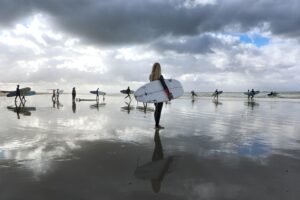Australian Immigration, Dreaming of the Red Continent, Which Immigration Program is Right for Me? Types, Conditions 2025
Australia, a country that is noted for its blue skies, endless nature, and stable welfare system.
The land of choice for immigrants from all over the world has become a symbol of diversity and opportunity.
Australia is actively seeking to attract skilled workers for economic growth and operates a systematic immigration system.
Skilled immigration in particular is attracting a lot of attention due to its high demand and clear criteria.
We have adopted a points-based system that selects applicants by scoring their academic background, career, age, English proficiency, and qualifications.
To be eligible to apply, you must be in an occupation listed on the Skilled Occupation List (SOL).
In addition to these, there are various other routes such as family invitation, investment immigration, and immigration after studying abroad, so a strategy tailored to each individual is necessary.
Now, let’s take a closer look at the main visa programs for Australian immigration and their conditions.
index
- 1. Basic understanding of Australian immigration
- 2. Technical Immigration Program
- Skilled Independent Visa (Subclass 189)
- Skilled Nominated Visa (Subclass 190)
- Skilled Work Regional (Provisional) Visa (Subclass 491)
- Temporary Skill Shortage (TSS) Visa (Subclass 482)
- Employer Nomination Scheme (ENS) Visa (Subclass 186)
- Regional Sponsored Migration Scheme (RSMS) Visa (Subclass 187)
- 3. Family Immigration Program
- 4. Business Innovation and Investment Immigration Program
- 5. Other Visas
- 6. Overview of the Immigration Application Process
- 7. Precautions and Restrictions
- 8. Conclusion: Start your Australian immigration journey
1. Basic understanding of Australian immigration
Australia is an attractive immigration country for many people due to its vast land, abundant natural resources, high quality of life, and multicultural society. In order to solve the shortage of skilled labor and sustain economic growth, it operates various immigration programs, and provides immigration opportunities by considering various factors such as individual skills, family relationships, and investment ability. The Australian immigration system is managed by the federal government, and each state and territory also operates its own immigration program to attract manpower that suits the characteristics of each region.

2. Technical Immigration Program
The Skilled Migration Program, which forms the core of Australia's immigration system, aims to attract skilled workers who can contribute to the Australian economy. It is based on a points system that scores applicants on factors such as their age, English language skills, work experience, education, qualifications, and connections to Australia. List of Australian Tech Jobs(Skilled Occupation List – SOL)If you have a job that is included in the list, you are more likely to apply.
The program selects highly trained professionals, particularly those in areas where there is a shortage of skilled workers within Australia, and also awards additional points to applicants who are willing to settle in a particular state or territory.
A higher score increases your chances of receiving an invitation, and competitive occupations may require higher scores.
After passing the skills assessment, you must receive a formal invitation from the immigration office to apply for a visa, so prior preparation is very important.
Skilled Independent Visa (Subclass 189)
This is a permanent visa that can be applied for independently without the support of a state government or family. It is available to applicants with high points scores and gives them the right to live and work anywhere in Australia.
- condition: Under a certain age, meet English proficiency criteria, have a valid skills assessment, have relevant work experience, meet high point scores, meet health and character requirements, etc.
- Limitations: No state or family sponsorship is required, but competition is fierce and high scores are required.
Skilled Nominated Visa (Subclass 190)
A permanent visa sponsored by a state or territory government. Additional points can be earned through sponsorship, and there may be conditions that require you to live and work in the sponsoring state for a certain period of time.
- condition: Under a certain age, meet English language proficiency criteria, have a valid skills assessment, have relevant work experience, meet points requirements, be sponsored by a state or territory government, meet health and character requirements, etc.
- Limitations: There may be a residency and employment requirement for a certain period of time in the state you are sponsoring.
Skilled Work Regional (Provisional) Visa (Subclass 491)
This is a temporary visa for applicants who intend to live and work in regional areas. You can apply through family sponsorship or regional state/territory sponsorship, and after obtaining the visa, if you meet certain conditions, you can apply for a permanent visa (Subclass 491).
- condition: Under a certain age, meet English language proficiency criteria, have a valid skills assessment, have relevant work experience, intend to live and work in a regional area, be sponsored by a family member or a local state/territory, meet health and character requirements, etc.
- Limitations: You must reside and work in a designated regional area for a certain period of time to be eligible to apply for a permanent resident visa.
Temporary Skill Shortage (TSS) Visa (Subclass 482)
This visa is for Australian employers to temporarily hire skilled workers from overseas. It is for certain occupations and requires employer sponsorship. This visa is divided into short-term stream, medium-term stream, and labor agreement stream.
- condition: Employer sponsorship, specific occupation, relevant experience and skills, meeting English language proficiency standards, meeting health and character requirements, etc.
- Limitations: This is a temporary visa and the path to a permanent visa may be limited.
Employer Nomination Scheme (ENS) Visa (Subclass 186)
This visa is for Australian employers to permanently employ skilled overseas workers. TSS visa holders may apply for a permanent visa if they meet certain conditions.
- condition: Employer sponsorship, specific occupation, relevant experience and skills, meeting English language proficiency standards, meeting health and character requirements, etc.
- Limitations: There are specific requirements for employers and positions.
Regional Sponsored Migration Scheme (RSMS) Visa (Subclass 187)
This visa is for regional employers to permanently hire skilled overseas workers. Similar to the ENS visa, but a separate stream for regional employers.
- condition: Sponsorship by a local employer, eligibility for a specific occupation, relevant experience and skills, meeting English language proficiency criteria, willingness to reside and work in a local area, and meeting health and character requirements.
- Limitations: You must reside and work in a designated local area for a certain period of time.
3. Family Immigration Program
Australia offers a range of family migration programs that allow family members to immigrate through sponsorship by an Australian citizen, permanent resident or eligible New Zealand citizen. Family reunification is a priority, and visas for immediate family members such as spouses, parents and children are the mainstays.
-
Partner Visa (Subclasses 820 and 801, 309 and 100)
This visa is available to spouses or de facto partners of Australian citizens, permanent residents or eligible New Zealand citizens. You must first obtain a temporary visa (820/309) and then, if your relationship continues, you can apply for a permanent visa (801/100).
-
Parent Visa (Subclasses 103 and 143)
This visa is available to parents of Australian citizens, permanent residents or eligible New Zealand citizens. The Non-Contributing Parent Visa (103) has a very long waiting period, while the Contributing Parent Visa (143) has a high application fee but allows for a relatively quick processing time.
-
Child Visa (Subclass 101)
This visa is available to children of Australian citizens, permanent residents or eligible New Zealand citizens.
-
Other Family Visas
In addition to the immediate family members listed above, there are limited family visas available for orphaned relatives, caregivers, etc.
4. Business Innovation and Investment Immigration Program
Australia operates a business innovation and investment migration program to attract entrepreneurs with innovative business ideas or individuals willing to invest significant assets. It is often sponsored by state and territory governments.
-
Business Innovation stream (Subclass 188A)
This is a temporary visa for businessmen who wish to own or manage a new or existing business in Australia. They must meet certain business and personal asset requirements and may be eligible to apply for a permanent visa (Subclass 888) through business activities after obtaining the visa.
-
Investor stream (Subclass 188B)
This is a temporary visa for individuals who are sponsored by a state or territory government and intend to make a specified investment. It requires significant investment assets and investment experience, and if the investment maintenance conditions are met after obtaining the visa, the applicant may apply for a permanent visa (Subclass 888).
-
Significant Investor stream (Subclass 188C)
This is a temporary visa for individuals who invest a significant amount of money (currently AUD 5 million) in Australia. If they meet the investment maintenance requirements, they can apply for a permanent visa (Subclass 888).
-
Entrepreneur stream (Subclass 188E)
This is a temporary visa for entrepreneurs with innovative business ideas. They must be sponsored by a state or territory government and meet specific business plan requirements. Once they have obtained the visa and meet the business success requirements, they can apply for a permanent visa (Subclass 888).
-
Business Talent (Permanent) visa (Subclass 132)
This is a permanent visa for entrepreneurs with outstanding business aptitude. There are two streams: the 'Significant Business History stream' for those with innovative business ideas and the 'Venture Capital Entrepreneur stream' for those who have received venture capital investment.
5. Other Visas
In addition to the Skilled Migration, Family Migration, Business Innovation and Investment Migration detailed above, Australia also has temporary visas for various purposes, and in some cases, they offer the opportunity to convert to permanent visas if certain conditions are met. These visas are mainly for short-term stays, but they can provide legal residency status to foreigners who can contribute to Australian society and economy, and can provide a stepping stone for long-term settlement.
-
Student Visa (Subclass 500): This visa is for international students who wish to study full-time at a registered education institution in Australia. It supports a variety of study purposes, including bachelor’s, master’s and doctoral degrees, as well as vocational education and training (VET) courses and language courses. During the study visa period, you may be permitted to work up to a certain number of hours per week, and after graduation, you may be able to pursue additional employment opportunities in Australia through the Graduate Work stream (Subclass 485) visa. If you fall into a skilled occupation and are sponsored by an employer, you may be able to find a route to permanent visas through the Temporary Skill Shortage visa (TSS – Subclass 482) or the Employer Nomination Scheme (ENS – Subclass 186). *Top 5 popular English-speaking study abroad countries Go see
-
Working Holiday Visa (Working Holiday Visa – Subclass 417 & 462): This visa allows young people aged between 18 and 30 (35 in some countries) to travel and work in Australia for up to 12 months. The visa can be extended for up to 2 or 3 years if certain conditions are met, and if you have worked in agriculture or certain industries for a specified period of time, you can apply for a second or third Working Holiday Visa. The Working Holiday Visa is a great way for young people to experience Australian culture and cover the cost of their stay through short-term work, and for some skilled applicants, it can be converted into a long-term work visa or permanent visa with sponsorship from an employer.
-
Visitor Visa (Subclass 600): This visa is for short-term visits, such as tourism, visiting relatives, or business purposes. It usually allows a stay of up to 3 months, but sometimes up to 6 months or 12 months. Employment is not permitted on a visitor visa in principle, but certain business-related activities may be permitted. A visitor visa does not generally allow you to apply for a permanent visa, but in very exceptional humanitarian circumstances, it may be possible to apply for another visa within Australia.
In addition to these, there are various temporary visas for specific occupations or special situations, and depending on the conditions and regulations of each visa, there may be a route to a permanent visa. Therefore, when considering immigration to Australia, it is important to accurately determine the type of visa that suits your situation and purpose, and to constantly check for changes in related laws and policies. Australian Immigration website (https://immi.homeaffairs.gov.au/” target=”_blank” class=”external-link”>https://immi.homeaffairs.gov.au/) for more detailed information on the various visa options.
6. Overview of the Immigration Application Process
The Australian immigration application process varies greatly in its steps and requirements depending on the visa an individual is applying for. However, for most permanent visas and some long-term temporary visas, the following common steps are required. It is essential to understand each step and prepare thoroughly to successfully obtain a visa.
-
Skills Assessment: When applying for a skilled migration visa, the first step is to have your education, career, skills, etc. assessed by an Australian agency to see if they meet Australian standards. List of Australian Tech JobsIt is conducted by an institution related to the occupation specified in , and a positive skills assessment result is one of the prerequisites for a visa application. Since the assessment institution and requirements are different for each occupation, you should check the accurate information in advance and prepare. Various documents such as degree certificates, career certificates, and employer recommendation letters are required for the assessment, and the assessment period may also vary depending on the institution.
-
Apply Online (SkillSelect): If you receive a positive result from the technical review, SkillSelectAn Expression of Interest (EOI) is submitted through the Australian Government's online system called SkillSelect. The EOI includes various information such as an individual's skills, work experience, education, and English language skills, and points are calculated based on this. If you are applying for a state government sponsored visa (Subclass 190, 491), you must first submit an Expression of Interest through SkillSelect and wait for state government sponsorship. SkillSelect is a system for the Australian Government to efficiently select and manage skilled workers.
-
Apply for State and Territory Nomination (if applicable): If you are applying for a Skilled Nominated visa (Subclass 190) or Skilled Work Regional (Provisional) visa (Subclass 491), you must apply for sponsorship from the relevant state or territory government after lodging your SkillSelect EOI. Each state or territory has its own criteria and requirements and may prioritise applicants with certain occupations or skills based on local labour market conditions. Being sponsored will earn you additional points, increasing your chances of being invited to apply for your visa.
-
Submitting a Visa Application: If you have received an Invitation to Apply (ITA) from SkillSelect, or are eligible for an Employer Sponsored Visa (Subclass 482, 186, 187) or Family Migration Visa, you can submit your visa application online through the Australian Immigration website. The visa application form must contain detailed information about your personal details, education, work experience, family relationships, health conditions, criminal record, etc., and must be accompanied by all required supporting documents.
-
Document preparation and notarization of translation: All documents submitted for visa application must be prepared in English. Documents in Korean must be translated by an accredited translation agency and notarized. Required documents vary depending on the type of visa, but generally include copies of passports, birth certificates, marriage certificates, degree certificates, transcripts, career certificates, employment contracts (if applicable), financial statements, skills assessment results, and English proficiency test results.
-
Medical Examination: Visa applicants must undergo a medical examination at a hospital designated by the Australian Immigration Department. This is a procedure to ensure that the applicant's health status meets Australian public health standards. The results of the medical examination will be reported directly to the Department of Immigration, and if there are certain diseases or health conditions, it may affect the issuance of a visa.
-
Police Checks: Visa applicants are required to undergo police checks in Australia and the country in which the applicant has resided. This is a process to check the applicant's criminal record and character requirements. Depending on the results of the check, the visa may be refused.
-
Visa Review and Approval: The submitted visa application and all supporting documents will be assessed by an Australian immigration officer. Additional information or documentation may be requested during the assessment process, and in some cases an interview may be conducted. The visa assessment period can vary greatly depending on the type of visa and the time of application, and if all requirements are met, the visa will be approved.
-
Visa issuance and entry into Australia: Once your visa is approved, you will receive a visa issuance notice and you can then prepare to enter Australia. The visa contains information such as the validity period for entry into Australia and the conditions of stay, so you should check these carefully.
As such, the Australian immigration application process can be complex and involves multiple steps. Official website of Australian Immigration
It is recommended that you check the accurate information in and, if necessary, seek the assistance of an authorized immigration agent.
7. Precautions and Restrictions
The process of preparing for immigration to Australia is complex and requires careful approach. Accurately understanding the eligibility requirements for each visa category and being aware of the various precautions and restrictions that may arise during the application process are the keys to successful immigration.
-
The importance of providing accurate and truthful information: When applying for an Australian immigration visa, you must provide all information accurately and truthfully. If you provide false or misleading information or omit important facts, you may not only be refused a visa but also be banned from entering Australia in the future. All documents you submit must be originals or certified copies, and if necessary, must be translated and certified.
-
Stay informed of changes in immigration law and policy: Australian immigration laws and policies are subject to change from time to time in accordance with the economic and social circumstances of the Australian government. In particular, in the case of skilled migration, the Skilled Occupation List (SOL) is updated periodically, and the weighting or required points of the points system may change. Therefore, while preparing a visa application, as well as during the processing of the application after the application, you should check the official website of the Australian Immigration Department (https://immi.homeaffairs.gov.au/, https://immi.homeaffairs.gov.au/) It is very important to keep up to date with the latest information.
-
Substantial visa application fees and non-refundable policies: Applying for an Australian immigration visa can be quite expensive, and in most cases, the application fee is non-refundable even if the visa is refused. Therefore, it is important to carefully review your eligibility before applying for a visa, and if necessary, consult with an accredited immigration agent to carefully assess your chances of success.
-
Cultural differences, language barriers and adjusting to new environments: After immigrating to Australia, you will need to adapt to cultural differences, English-speaking environments, and new lifestyles that are different from those of Korea. Especially when immigrating to regional areas, you will need to make an active effort to adapt to the local community atmosphere and living environment that are different from those of large cities. It will be of great help to successfully settle down if you acquire sufficient information about Australian culture and living in advance and improve your English skills.
-
Specific conditions for regional immigration: If you have obtained a regional immigration visa, such as the Skilled Work Regional (Provisional) visa (Subclass 491) or the Regional Sponsored Migration Scheme (RSMS) visa (Subclass 187), you are required to reside and work in a designated regional area for a certain period of time according to the conditions of the visa. If you breach these conditions, your visa may be cancelled, so if you are considering regional immigration, you should carefully consider the living environment and employment opportunities in the area.
-
Importance of health and personality requirements: In order to apply for an Australian immigration visa, you must meet health and character requirements. If you have a serious illness or criminal record, your visa may be refused. These requirements are assessed through medical examinations and identity checks, and you must honestly report any criminal records.
Immigrating to Australia is a major decision that will bring about a big change in an individual's life. Therefore, taking enough time to prepare carefully and making plans based on accurate information will be the first step to successful immigration to Australia.

8. Conclusion: Start your Australian immigration journey
Australian immigration offers a variety of opportunities, but careful preparation and accurate information are essential for successful immigration. We hope that the information provided in this article will help you take the first step in your Australian immigration journey. The official website of the Australian Government (https://immi.homeaffairs.gov.au/) for up-to-date information and, if necessary, consider seeking professional advice from an accredited immigration agent. We support your dreams of starting a new life on the Red Continent.
*TOP 5 Immigration Countries Preferred by Koreans Go see


